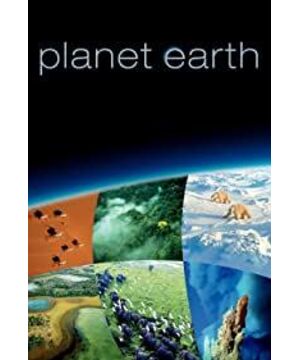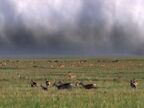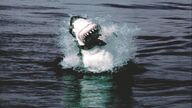l Introduction
The BBC once produced the documentary photography team of "Blue Planet", and once again assembled and presented this unsurpassed classic documentary "Earth Pulse". From the Antarctic to the North Pole, from the equator to the frigid zone, from the African grassland to the tropical rain forest, and from the desolate peak to the deep sea, countless creatures are presented to the world in extremely beautiful forms. We saw the rise and fall of the floods in Okavango and the living conditions of the animals that depended on the surrounding areas. We saw the rare pictures of snow leopards hunting in the heavy snow. We saw the interdependence of penguins, polar bears, seals and other creatures on the ice sheet. The harsh scene also saw amazing creatures living in the high temperature environment of the crater deep in the ocean. And, of course, the spectacular beauty and peculiar landforms from all over the planet, selflessly showing their brightest side.
l Notes
Episode 1 From Pole To Pole (Between the Poles)
The Earth as a whole explores the key factors that shaped the Earth's natural history. Without fresh water, there would be no life on land; the sun controls all the animals and plants on earth and determines their living environment. The effect of the sun on life is most mesmerizingly displayed during the arctic spring.
Almost half of all polar bear cubs die on the ice in the first year after exiting the burrow.
Some reindeer herds migrate more than 3,000 kilometers a year to find fresh pastures, the longest land migration in the animal kingdom.
If the little reindeer makes no mistakes, the wolf will give up after chasing more than 1,000 meters.
Leopards are the rarest cats in the world.
The fate of the leopard illustrates the fragility of natural life, and the future of the species will depend largely on the survival of the already small number of female leopards.
The Earth revolves around the sun once a year, but its axis is tilted, and it is this tilt that creates the seasons.
Equatorial forests cover only 3% of the Earth's surface, yet it has more than 50% of the world's flora and fauna.
The most abundant place for life in the ocean is the waves and currents.
Piranha sharks swim very fast, but they are not as nimble as fur seals when they turn sharply.
High winds from the ocean cross the seas and across the state into the interior, causing the world's largest dust storms as they blow across the Sahara. The dust travels halfway across the globe, bringing nutrients to the Amazon jungle.
Deserts cover one-third of the land area, and this proportion is expanding every year.
Egyptian baboons are frightened when they swim.
Impalas are hyenas' favorite prey.
When hyenas approach their prey, they separate, forming a circle around the prey.
Episode 2 Mountains (Majestic Mountains)
Welcome to a world of extremes, rocks and ice. We will embark on a journey of the most majestic mountain range - from the formative mountain range that rises in the lowlands straight to the top of Mount Everest, and discover some mysterious creatures born to meet the challenges of alpine life, among which we will also see to some of the rarest phenomena such as lava lakes.
Some people may think that climbing the mountain means conquering the mountain, but we are all just passing by.
Elitarles is by far the longest continuous eruption volcano on Earth. It is actually a lava lake that has been boiling for over 100 years.
Griffon baboons have the strongest fingers of any primate and are fearless.
For all monkeys, morning is a time for grooming and a great opportunity to make friends. But unlike other monkeys, lion-tailed baboons keep talking while grooming each other.
Griffon baboons are the only monkey species in the world that eat almost exclusively grass.
The climate in the Andes is one of the most unstable mountain climates on earth, with blizzards occurring without warning, and it can be described as four seasons in one day.
Thousands of avalanches occur every winter in the Rocky Mountains of the United States, destroying hillsides.
Sometimes male grizzly bears eat cubs.
The Rocky Mountains are no longer rising, only very slowly disintegrating.
Mont Blanc is the highest mountain in western Europe.
Glaciers are the most powerful etching forces on Earth.
Botero Glacier is the largest alpine glacier on Earth, about 70 kilometers long and 5 kilometers wide.
The Himalayas have the highest concentration of peaks above 8,000 meters in the world.
Snow leopards are the most exotic animals in the Himalayas.
With a wingspan of 2 meters, the golden eagle can easily grab a baby goat.
Giant pandas don't have enough body fat to hibernate themselves.
Like the giant panda, the golden monkey is also an animal unique to China.
The red panda is a rare animal in the wild. It used to be considered a raccoon, but it is now considered a small mountain bear.
Giant panda cubs cannot fully open their eyes until three months later, and the survival rate is very low.
No creature can survive long on Mount Everest.
One in ten people who climb Mount Everest die.
Episode 3 Freshwater
Freshwater is our most precious resource, and it determines the distribution of life on Earth. Along with the river, descend from the high peaks all the way to the sea, watch the spectacular waterfalls, fly in the Grand Canyon, explore the wild life under the snow and ice of the deepest lake in the world, and witness the unique and vivid behavior of animals One side: The otter and the crocodile will face off.
Only 3% of the water on Earth is freshwater, but all life on land ultimately depends on this freshwater.
Angel Falls is the waterfall with the largest drop in the world, with a drop height of nearly 1,000 meters.
The giant salamander is the largest amphibian in the world, with a body length of nearly 2 meters and a lifespan of up to 80 years.
The salmon migration is the largest fish migration in the world.
Canada's brown bear is very special, it has learned to dive to hunt for food.
The Colorado River has carved out the longest canyon system in the world, and the 1,000-mile-long notch is clearly visible from space.
India's rivers are home to the largest number of social otters in the world, with groups of up to 17 individuals.
Crocodiles' jaws are as strong as steel pliers, and once they bite, they never let go.
Worldwide, lakes hold 20 times as much fresh water as rivers.
Among the world's largest lakes, there are three in the Great Rift Valley region: Lake Malawi, Lake Tanganyika and Lake Victoria.
Lake Malawi has the most fish of any lake in the world, with 850 species of cichlids alone.
Lake Baikal is the largest and oldest lake in the world. It is more than 600 kilometers long and more than 1,600 meters deep, and its water volume accounts for one-fifth of the total fresh water of all rivers and lakes on the earth.
More than 80% of Baikal's species are unique.
The undisputed super river on earth is the Amazon, whose flow is the sum of the flow of the next ten largest rivers.
The Amazon River carries as much as 1 billion tons of sediment every year.
Male Amazonian finless porpoises courtship in a unique way, holding stones in their mouths to show off to their favorite female finless porpoises.
The Pantanal is the largest wetland in the world.
Episode 4 Caves (Cave Labyrinth)
The mysterious and unusual aspects of the cave often go unnoticed, but there are also some bizarre wildlife living there: the cave angelfish suspends itself from the wall behind the cave waterfall by means of subtle hooks growing from its flattened fins ; Cave swiftlets navigate through a sonar system, and it's amazing how long they live in a hidden world full of stalactites, stalagmites, and burrowing creatures.
The Swallow Cave in Mexico is the largest cave on Earth and the last place on our planet to be involved in human exploration.
Caves are the least explored places on earth by humans.
The vast majority of caves in the world are made of limestone.
Deer Cave on Galipangan Island is the largest underground river channel in the world.
Peregrine falcons and manta kites are jet fighters in the bird world.
Like bats, swiftlets rely on echoes for guidance.
Water is not only an eroder of caves, but a builder at the same time.
Sailfish are like bats in the sea, leaving their burrows every evening to hunt for food.
At present, there are less than 100 child-like axolotls in the wild.
It takes thousands of generations of evolution to lose eyes.
Episode 5 Deserts (Deserts)
About 30% of the land surface is desert, and although these areas are severely water-stressed, the ecosystems are unusually diverse. Uncover the secrets of survival in the desert region and experience the ephemeral nature of this dynamic system.
A stomach full of snow can be fatal.
The Sahara Desert in Africa is the largest desert in the world, and its area is almost the size of China.
Dromedaries can walk freely in dust storms.
All deserts are formed by winds that entrain sand and dust.
Australia is the driest continent in the world.
All small desert animals are nocturnal.
Chile's Atacama Desert is the driest desert in the world, and some places can go up to 50 years without rain.
Saguaro's branches can store up to 5 tons of water, which makes it enough to endure months of drought.
Lizards are the inhabitants of deserts.
Deserts are caused by lack of water, but it is not heat or drought that kills animals here, but lack of food.
Elephants in Namibia are the most hard-working of all African elephants. They walk nearly 100 kilometers along the dry river every day in search of food.
Grass is the staple food of all elephants.
The fate of many desert animals is determined by rain in the distance.
Death Valley in the American Southwest is the hottest place on Earth.
No other species responds to good times faster than the desert locust.
Adult locusts eat as much as their own body weight per day, and a swarm can eat several tons of food per day.
Several locust swarms meet to form a huge pest swarm, with a number of billions and a width of 60 to 70 kilometers.
Episode 6 Frozen (The Frozen World)
Planet Earth will continue its astonishingly enjoyable journey. We will follow the camera on an impressive tour of the Antarctic and North Pole in the most extreme seasons, and time-lapse cameras will take a close look at a colony of emperor penguins to show us the dynamics involved in emperor penguin behavior.
90% of the ice on Earth is in Antarctica.
Even in the height of summer, less than 3% of Antarctica is not covered by snow and ice.
Male emperor penguins endure the coldest and darkest winters on Earth without the sun with their eggs.
In the Arctic, breaking the ice equates to a chance of survival.
In a sense, the pygmy puffin is the penguin of the Arctic. They also lay eggs on exposed rocks, and they look like penguins.
Short-tailed Skuas are capable of driving away any trespassers, including large herbivores.
Polar bears sometimes even swim as far as 100 kilometers from the coast to hunt for food.
The polar bear's claws and teeth can't penetrate the thick skin of a female walrus.
Polar bears risk attacking dangerous prey only when they are very hungry in midsummer.
Penguins' desire to become parents is so strong that they sometimes fight over the adoption of little penguins who have lost their parents. Many of these disputes end in tragedy, as the poor little baby is trampled to death.
Episode 7 Plains
The crew turned the camera on the terrified Mongolian duiker, whose seasonal migrations were actually witnessed by very few people. At the same time, you won't miss the weird-looking Tibetan fox that first appeared in the camera lens. For six weeks, the crew used night-vision goggles to film the melee at close range in order to track a lion that was trying to kill an elephant.
Grasslands support the largest populations of wildlife on our planet.
A quarter of the earth's land area is covered by grass.
Like a phoenix nirvana, grass grows incredible from the ashes.
With 1.5 billion red-billed quelias in the African savannah, it is the most numerous bird on the planet. Some flocks are so large that it takes 5 hours to fly over your head.
Grasses grow not only in the tropics, but even in harsh conditions like the Arctic.
Xueyan is loyal to one partner for life.
Caribou can travel nearly 50 kilometers a day, more than 3,000 kilometers in a summer.
Only fat little foxes can survive arctic winters.
No animal can afford indiscriminate hunting and habitat destruction.
In all temperate grasslands around the world, summer is the season when animals grow and reproduce.
The Tibetan Plateau is the highest grassland in the world.
Elephant grass is the tallest grass in the world.
Elephants have the same vision at night as humans.
Lions don't normally hunt elephants, but they will take risks when desperate.
Whether it's flooding, fire, drought or freezing, grass can withstand it.
Episode 8 Jungle (The Rich Forest)
The jungle covers about 3% of the earth's area, but 50% of the species on earth live. High-definition cameras allow us to see an unprecedented picture of life in the dark jungle.
Tropical rainforests cover only 3% of the world's land, yet the species that live here account for more than half of the world's total.
In 100 square meters of rainforest there may be 250 different tree species, which is equivalent to nearly 10 times the total tree species growing in the UK.
The blood tung tree grows 8 meters in one year, leaving almost all the competitors behind.
Fig trees are able to provide fruit continuously throughout the year.
Figs are so popular that a single fig tree attracts 40 different species of birds and monkeys.
Different tunes are played on each upper and lower level of the rainforest, and this chorus is especially colorful in the early hours of the morning.
The ears of frogs have the unique function of hearing only the calls of the same species.
A tree can absorb hundreds of tons of water every year, but the tree itself can't use that much water, and most of the water is evaporated into the air, becoming fog and clouds.
In the Amazon rainforest, the largest in the world, half of the rainfall comes from clouds that form when water evaporates from trees.
It is estimated that there are nearly 1 million different fungi in the tropics, the vast majority of which are unknown.
80% of the world's insects live in jungles.
Few insects are more successful than ants, with 8 million ants per 100 square meters of woodland.
The fruiting bodies of the Cordyceps fungus can grow from the heads of dead ants.
Each Cordyceps species is specialized against one species.
The secret to success in the competitive jungle is specialization, which has evolved a very close relationship between animals and plants.
The safflower spends its entire life in pitcher plants.
In the jungle anything can be contested, including a small pitcher plant riding on water.
The chimpanzees in the forests of Uganda are the largest group of chimpanzees found in Africa.
Rainforests are some of the most delicately balanced ecosystems in the world.
Episode 9 Shallow Seas
Here are the newly discovered dwarf seahorses in Indonesia's Coral Sea, 'electric' clams and clumps of venomous sea snakes. There are also scenes of sea urchins falling into giant seaweed jungles, and huge cowhide sea lions preying on South African king penguins. And the scene where these penguins took the courage to fight with the sea lions regardless of their weight disadvantage is really wonderful.
The combined area of all shallow seas only accounts for 8% of the ocean area on the earth, but the vast majority of marine life lives in shallow seas.
Australia's Great Barrier Reef is so large that it can be seen from the moon.
In Indonesia's reef waters, there are almost as many species of fish as there are in the entire Caribbean, and 10 times as many species of coral as there are in the Caribbean.
Corals hunt 24 hours a day.
Today, only 6 percent of Indonesia's coral reefs remain in their original state.
Elephantine algae is the only flowering plant that can grow in the sea.
Manatees are the largest herbivores in the ocean, growing up to 3 meters long and weighing half a ton.
It is a common hunting method for dolphins to stun the target by slapping the target with the tail.
The charred Arabian sand prevents the bay from becoming just another desert—a desert in the sea.
Algae are tiny, but they produce three-quarters of the oxygen in the atmosphere.
In terms of weight, the total weight of any animal on the planet cannot be compared to krill, and a group of krill weighs 2 million tons.
The shallow temperate seas are home to the largest population of fish on earth.
Each sea urchin has five teeth that sharpen themselves and are replaced every few months.
In temperate oceans, there may actually be more squid than fish.
Short-tailed rays are the largest of the stingrays and like to travel in pairs.
The great white shark is the largest carnivorous fish on earth.
King penguin cubs depend on their mothers for more than a year.
Sea lions usually feed on krill, but now surprisingly like to eat penguins.
Shallow seas are the most prosperous and concentrated areas of life on Earth.
Episode 10 Forest (Season Forest)
On the edge of the Arctic lies a vast coniferous forest, a silent world of dwarf conifers. Those trees may be really short, but when photographed from above, the trees show their true size. One-third of the world's trees grow here, and in the short summer months, these trees produce enough oxygen to change the composition of the atmosphere.
Trees are the most magnificent sights of life on earth, and some of them are the largest living things on earth.
The number of trees in the taiga forest is the sum of the world's rainforest trees, accounting for one-third of the world's total trees.
At the northern end of the Taiga Forest, the growth period of trees is only one month a year, and a sapling may take 50 years to grow larger.
Lynxes are like ghosts. Even if you live in these woods all your life, you may not see a lynx once.
This redwood in California is home to three of the tallest trees in the world, one of which is more than 100 meters tall and as tall as a 30-story building.
The bristlecone pines are some of the oldest trees on Earth, some are 5,000 years old.
Purdue deer are the smallest deer in the world.
The South American linden cat is the smallest cat in the Americas.
Mandarin ducks use tree holes as nests.
Seventeen-year-old cicadas number more than 1 billion, making it the largest insect team on the planet.
Seventeen-year-old cicadas die one after another after mating, and their nutrients return to the soil, which may be the largest dose of fertilization in nature.
When it comes to alertness, no one can match a deer.
Baobab buds can fully open within a minute.
The Japanese lemur is the smallest primate in the world.
Seasonal forests are the largest forests on Earth.
Episode 11 Ocean Deap
You'll see how the 30-ton whale shark eats all the fish, and you'll get a special high-level view of how the dolphins speed up. Step into the depths of the ocean, and you'll see octopuses with "wings" and vampire squids that change colors using glowing bodies in their bodies. There are also shots of eels, crabs, and tall pods that completely eat food for hours at a depth of 2,000 meters.
The vast majority of the ocean is currently inaccessible to humans.
Most of the oceans are nothing but water-filled deserts.
The largest of all fish is the whale shark, which weighs 30 tons and is 12 meters long.
The huge schools of fish on which many marine animals depend are only present when the conditions are fully met.
The long, fixed pectoral fins of the long-finned pinhead shark allow it to swim quickly through the water while expending minimal energy.
Mammoths dive to fish, and they can dive to depths of 20 feet.
Crabs can distinguish the faintest smells in the water, which helps them find dead animals.
Pachypterans are the fastest growing marine invertebrates known to date.
There are some submarine volcanoes higher than Mount Everest.
Nautilus only needs to eat food once a month.
Frigatebirds are capable of continuous flight at sea for months.
Seabirds around the world seek out remote islands in order to reproduce and raise their young.
Most baby turtles break out of their shells at night.
Many baby turtles drown in the surging waves.
The blue whale weighed nearly 200 tons, twice the weight of the largest dinosaur.
Not long ago, there were 300,000 blue whales swimming in the ocean, and now less than 3 percent of that number remain.
In our hands today is not just the future of whales, but the future of the entire natural world on our living planet.
We can destroy it completely, or we can take care of it and let it continue to thrive, the choice is ours.
l Short Comments
Zhuangzi said, "Heaven and earth have great beauty but do not talk about it, there are clear laws in the four seasons but do not talk about it, and everything has a rationale but do not talk about it." "Earth Pulse" is such a documentary - rushing rivers, majestic mountains, deep caves, Ice and snow world, blue ocean, vast desert, fantasy jungle, vast grassland... Every episode is an absolute visual feast.
The stork crane that travels over the mountains and mountains to spend the winter in India performs the most challenging migration on earth every year-flying over the Himalayas, a moat called "even a bird can't fly"; Wave salmon, traveling hundreds of miles across the entire northern hemisphere just to return from the ocean to their spawning grounds, make up the world's largest freshwater fish migration; hundreds of millions of snow geese, Overwintering in the Gulf of Mexico, in spring they fly all the way across North America to the green arctic tundra, which means a marathon migration of 3,000 miles that takes more than three months; Mongolian gazelles In order to reproduce offspring and cross the vast grasslands, this is the largest migration on earth once a year, but it is rarely witnessed... In front of such a beauty, I clearly feel the insignificance of human beings.
Finally, to quote the closing sentence, "It's not just the future of the whale that today lies in our hands. It's the survival of the natural world in all parts of the living planet. We can now destroy or we can cherish. The Choice is ours." (Not only the fate and future of whales are in our hands, but the survival of all life on this planet. Either exterminate them or care for them. It is up to humans themselves.)
View more about Planet Earth reviews










